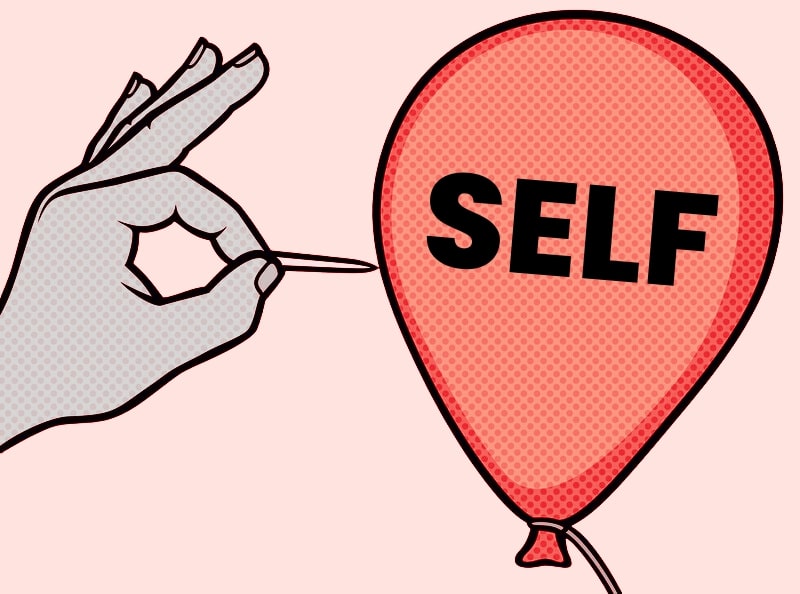Table Of Contents
- Self-Destructive Behavior As A Coping Mechanism
- Self-Destructive Behavior As A Means To Exert Control
- What Causes Self-Destructive Behavior?
- Traits Self-Destructive People May Share
- Types Of Self-Destructive Behavior
- The Helper-Helpee Relationship
- Healing And Recovery From Self-Destructive Behaviors
Trigger Warning: The following article will be discussing self-destructive behavior. If you are someone who is prone to self-destructive behavior or self-harm, please be aware that the material may be triggering.
The field of mental health is composed of many smaller parts, not all of which are considered a condition to be diagnosed.
Self-destructive behavior is one of those components.
It is seen as a symptom of other underlying dysfunction or psychological disorders that a person may be experiencing.
Though there have been studies that confirm self-destructive behavior is part of certain disorders, there is an absence of solid evidence that self-destructive behavior exists in people without underlying dysfunction or psychological diagnoses.
There are few studies or documented evidence that a typical person who meets the criteria for mentally and emotionally healthy will engage in self-destructive behavior.
It’s important to understand that this doesn’t mean it doesn’t happen. It just doesn’t happen often enough in people that would be considered mentally and emotionally healthy to be cited as a solid statistic.
As a result, self-destructive behavior is often looked at as a symptom of other underlying psychological issues.
Self-destructive behavior covers a wide variety of types and severity of behavior ranging from drug and alcohol abuse through to self-harm and social isolation. It may be intentional or subconscious, impulsive or planned. It can be either an action, series of actions, or a way of life that causes psychological or physical harm to the person engaging in the behavior.
Self-destructive behavior may start off small and escalate, even going as far as leading to death for some people.
The best way for a person struggling with self-destructive behavior to reach a favorable outcome is through early identification, intervention, and treatment.
Speak to an accredited and experienced therapist to combat your self-destructive behavior. You may want to try speaking to one via BetterHelp.com for quality care at its most convenient.
Self-Destructive Behavior As A Coping Mechanism
Emotional pain or trauma are some of the most common reasons for people to engage in self-destructive behavior.
The person substitutes healthier coping mechanisms for harmful coping mechanisms because it may feel better, may make the person feel more numb, allow the person to mask their genuine feelings, or they may just not know how to cope in a healthy way.
The individual may also use self-destructive behaviors as a form of punishment for a lack of control over themselves, their world, or their actions.
This type of self-destructive behavior also ties into what is considered to be a “cry for help.” The person may not know how to ask for help and engages in a visible destructive action to signal that they are in distress and need help.
A person who engages in self-destructive behavior may not be thinking from a rational or conscious place. They may be addicted to the feelings and feel a compulsion to engage in that behavior.
Self-Destructive Behavior As A Means To Exert Control
The world is a chaotic place. People get tossed, turned, and dragged down paths they may not want to walk. Not all of them good or healthy.
Those that feel out of control of themselves and their life may engage in self-destructive behavior as a means to feel as though they have control.
The person may not have control over what their boss does, what their spouse thinks, whether or not they lose that job, whether or not they get approved for that loan…
…but they do have control over what they put in their body and how they treat themselves.
That person may not feel a compulsion or have an addiction to self-harm – they choose to do it, almost as an act of defiance in the face of whatever is making them feel like they are out of control.
There is a more difficult facet of this type of self-harm…
Regular self-destructive actions can become a part of a person’s personality. The person may cease to see it is as a thing they do as a coping mechanism and instead see it as a part of their identity, which makes the problem that much more complicated to fix.
As an example…
Brian works a stressful job. After work, he stops at the local bar to have a couple drinks to shed some of the day’s stress before he heads home for the night.
After Brian finds a new job, he may still find himself going out for those few beers because that’s just what he does. Substance abuse is a part of his routine, becomes a part of his identity, and it could be or evolve into alcoholism.
What Causes Self-Destructive Behavior?
The question of what causes self-destructive behavior is an infinitely complex one because of how broad of a category self-destructive behavior is.
It can extend into every facet of life – friends, family, romantic, chemical, professional, food, and so many more.
Many people who engage in self-destructive behaviors are somewhat aware of their own destructive tendencies, but fail to do anything meaningful to stop or change them.
They may very well know the solution and make every excuse, find every reason to avoid stopping or changing.
Many self-destructive behaviors start off pleasurable. A person may start doing drugs or drinking to be able to feel good for a little while.
As the habit goes on, it stops feeling as pleasurable or it takes much more for the person to reach the point where they can derive a pleasurable feeling from the activity.
Addicts and alcoholics may eventually find themselves needing their drug of choice just to feel normal as their body and brain begins to need the substance to function.
At some point, those once pleasurable behaviors cease to be pleasurable and become a detriment to the person’s life.
Not all self-destructive behaviors are pleasurable. As an example, there are people who choose not to control their rage or anger. It may cost them friendships, relationships, jobs, safety, or stability.
They may see and understand that their anger issues are detrimental to their well-being, but they may refuse to change that behavior.
Though there is no single driving factor behind self-destructive behavior. The person may have unaddressed trauma or grief in their history. They could have unhealthy habits that have fostered through their general lifestyle.
They may be experiencing problems that they do not feel comfortable seeking help with. They may also engage in self-destructive behaviors to cope with the chaos and difficulty that life can throw our way.
What it is not is a weakness of character or a superficial desire to self-destruct.
People have this general need to find a reason behind actions or choices, but the reason often isn’t clear or may be purposefully hidden.
Emotionally healthy, happy people do not want to turn their life inside out with self-destructive behavior. If a person engages in self-destructive behavior, there is a reason that needs to be addressed with an appropriate certified mental health professional.
Traits Self-Destructive People May Share
Though there are some traits that people with self-destructive behaviors may share, most people will not fall neatly into a perfectly packaged category.
Not all people with self-destructive behaviors will share these traits, so we should avoid trying to cram people into neat packages they don’t belong in.
Emotional dysregulation is a phrase that is used in mental health to denote an emotional response that falls outside of the scope of what is considered to be typical.
A person who experiences emotional dysregulation may act rashly or impulsively, display unnecessary aggression, or have emotional reactions that are not in line with what they are experiencing.
Emotional dysregulation is often a driving force behind self-destructive behaviors. It can result from brain injuries, early childhood trauma like neglect and abuse, or a variety of psychiatric disorders and mental illnesses.
People with emotional dysregulation may feel emotions with greater intensity or clarity. They may be a highly-sensitive or exceptionally emotional person.
It’s not necessarily negative. These individuals may also be more creative and empathetic than the average person.
A person may also have grown up in an invalidating, adverse, or toxic environment. That may include experiences like abuse, neglect, and abusively severe criticism.
The person may have been exposed to or raised by people who are emotionally unintelligent, invalidate emotions, or who, themselves, engage in self-destructive behaviors as a coping mechanism.
They may have been exposed to bullying by their peers at school, ostracization, or other social alienation throughout childhood.
Many people do not know how to process and cope with difficult emotions in a healthy way. They may decide to ignore their pain or deny that it exists by trying to turn off their emotions.
Unfortunately, emotions don’t work that way. They eventually start to come to the surface and some people turn to self-destructive behaviors like drugs and alcohol to self-medicate.
The person may find success in coping with their unwanted feelings in the short-term with these behaviors, but they get worse and more intense as time goes on.
Upon learning that one of these short-term solutions helps them find relief, the person is likely to go back to that behavior over and over for more relief, which can turn into dependence and addiction.

Types Of Self-Destructive Behavior
There are numerous types of self-destructive behavior. It would be impossible to list out every example. Instead, these are some of the more common types of self-destructive behavior that people engage in.
Drug and alcohol abuse
Substance abuse is one of the most common forms of self-destructive behaviors. It can easily lead to addiction, negatively impact relationships, and destroy opportunities and employment. It can also lead to other physical and mental health complications.
Self-harm
Self-harm such as cutting may be used as a coping mechanism to deal with severe or extreme emotional disturbance. The person may even get addicted to self-harm.
Unhealthy eating
Regular unhealthy eating habits, too much or too little, can lead to eating disorders like anorexia or bulimia.
Emotional eating can cause a person to gain weight, which not only has physical health ramifications, but may contribute to mental health issues like depression and anxiety.
Self-pity
A person may wrap themselves in their suffering and use it as a shield to try to deflect responsibility.
As a result, it will damage their relationships and life as they may come to be seen as burdensome to deal with and they lose out on opportunities.
In general, people are compassionate and empathetic, but they always have a limit. Once that limit is reached, it will start to negatively affect the person who uses their problems as an excuse to not try new things or improve at all.
A person who regularly tells themselves they are not worthy, whether they believe it or not, may come to believe it as truth and stop taking healthy risks or trying to improve.
Self-sabotage
The act of self-sabotage is setting oneself up for failure from the start. That may be the result of low self-esteem, as they may not feel as though they deserve to have good things or make positive strides in their life.
Self-sabotage may cost them relationships, jobs, and other opportunities that require a person to take some risk.
A good example of self-sabotage is the eternal pessimist; the person who can always find a reason as to why it’s not worth trying, why nothing will ever work out.
Social isolation
People are generally social creatures. There are very few people who can survive no social interaction at all.
Even the act of being around other people provides different benefits from stimulating chemical production in the brain.
A person may isolate themselves from friends, family, and social networks as either an active or subconscious choice. They may convince themselves that they do not deserve to have the friends and family that they do and will act on making it so.
This may look like the person dropping contact and ghosting or picking fights and engaging in arguments to cause the other person to want to break contact.
Unnecessary spending
The spending of money can evolve into a self-destructive behavior. Gambling and gambling addiction are well-established as self-destructive behaviors.
One can also include unnecessarily buying things from the internet, excessive shopping from brick and mortar stores, buying upgrades and currencies from mobile games or apps, or excessively donating to good causes.
Spending becomes an unhealthy behavior when it starts negatively impacting one’s ability to conduct their life, or if a person feels mentally compelled to spend when they are lacking the means.
Neglect of the self
Neglecting oneself is a common and oftentimes severe form of self-destructive behavior.
The person may neglect to take care of their physical health, eat a good diet, get exercise, or visit a doctor for either regular checkups or when an illness arises.
Neglecting mental health may be refusing to take prescribed medications, attend appointments, or even acknowledge mental health problems at all.
The person simply refuses to do anything to protect or grow their health. The person may also refuse any outside help or advice.
Unnecessary martyrdom
There are some people who use excessive self-sacrifice as an easy way to sidestep hard work.
They create this false narrative in their mind that their suffering is the only way that things will work out or be good for others. They stick to that false narrative instead of trying to improve themselves or their situation.
It’s a means to temporarily feel good about oneself by painting their actions as altruistic when the person is actually engaging in self-destructive behavior by using denial to avoid confronting their problems.
Sabotaging friendships and relationships
The person may sabotage their friendships and relationships as a means to further reinforce and convince themselves that they are an awful person who is not worthy of friends or love.
The behaviors associated with sabotage include jealousy, possessiveness, excessive neediness, passive aggression, gaslighting, manipulation, or even violence.
The behaviors may either be a subconscious drive or conscious choice. Either way, they typically stem from the person’s belief that they are not worthy of love.
The Helper-Helpee Relationship
A person’s self-destructive behaviors rarely only affect them. They typically spill out into their lives and affect the people around them.
Friends, relatives, or lovers may find themselves getting pulled into a helper-helpee relationship with a person who is displaying self-destructive behaviors.
Boundaries become an essential part of that relationship. The helper is likely to experience some negative impact on their life or well-being while in proximity to that kind of behavior.
While some people will interpret that as an unkind statement, it is worth remembering that excessive self-sacrifice can also be a common form of self-destructive behavior.
There is nothing unhealthy or wrong about healthy boundaries and expectations.
There are people who choose to get wound up in the suffering of others because it gives them a good reason to ignore their own problems. Or, they are trying to earn love from someone who isn’t in a position to give it.
Does that mean that a person shouldn’t try to be kind or understanding?
Not at all.
What it does mean is that we must always remember that you can’t help someone that doesn’t want to help themselves.
Destroying your own life or well-being for a person who won’t help themselves is not a solution.
It’s enabling.
Enabling another person’s self-destructive behaviors just makes them worse and harder to correct in the long-term.
It may also take much longer for that person to realize that they need to make a change if the people around them are tolerating excessive bad behavior.
A healthy support network can make a massive difference to a person’s ability to recover and find a better way to heal or manage their wounds. But, one must balance their willingness to help with maintaining their own well-being in the process.
Healing And Recovery From Self-Destructive Behaviors
The process of self-improvement is long and sometimes difficult.
No one really wants to dig through the shadows of their past to unearth the things that have caused them great pain or suffering…
…but it’s necessary.
It’s necessary because we are all the product of our life experiences – good and bad.
The ability to process severe emotions, like those associated with trauma or grief, is not innate. It’s a skill that must be learned and practiced to help unwind those emotions so they can be put to rest.
In all likelihood, that’s going to require the help of a therapist for most people. A therapist can serve as an effective guide to help someone identify and deal with the underlying causes of their self-destructive behavior. Of course, working through things via self-help is possible but it’s way harder and much less likely to succeed. A therapist is definitely your best bet.
BetterHelp.com is a website where you can connect with a therapist via phone, video, or instant message.
You’ve already engaged in some self-love just by searching for and reading this article. You are ready to take the next step and get the professional help that can make all the difference.
And online therapy is actually a great option – not only is it more convenient than in-person therapy, it is typically more affordable too.
And you don’t have to sacrifice on quality or the effectiveness of the therapy because you get access to a fully qualified and experienced professional.
Here’s that link again if you’d like to learn more about the service BetterHelp.com provide and the process of getting started.
And if someone you love is engaged in self-destructive behaviors, the best choice is to direct them towards the professional help they need.
You may also like:
- 11 Symptoms Of A Self-Loathing Mindset (+ How To Overcome It)
- Why Do I Hate Myself So Much?
- How To Stop Making The Same Mistakes Again And Again











